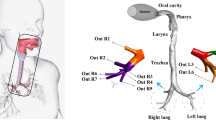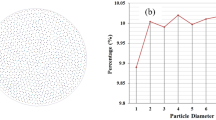Abstract
Magnetic drug targeting (MDT) is a local drug delivery system which aims to concentrate a pharmacological agent at its site of action in order to minimize undesired side effects due to systemic distribution in the organism. Using magnetic drug particles under the influence of an external magnetic field, the drug particles are navigated toward the target region. Herein, computational fluid dynamics was used to simulate the air flow and magnetic particle deposition in a realistic human airway geometry obtained by CT scan images. Using discrete phase modeling and one-way coupling of particle–fluid phases, a Lagrangian approach for particle tracking in the presence of an external non-uniform magnetic field was applied. Polystyrene (PMS40) particles were utilized as the magnetic drug carrier. A parametric study was conducted, and the influence of particle diameter, magnetic source position, magnetic field strength and inhalation condition on the particle transport pattern and deposition efficiency (DE) was reported. Overall, the results show considerable promise of MDT in deposition enhancement at the target region (i.e., left lung). However, the positive effect of increasing particle size on DE enhancement was evident at smaller magnetic field strengths (Mn \(\le \) 1.5 T), whereas, at higher applied magnetic field strengths, increasing particle size has a inverse effect on DE. This implies that for efficient MTD in the human respiratory system, an optimal combination of magnetic drug career characteristics and magnetic field strength has to be achieved.
















Similar content being viewed by others
Abbreviations
- x :
-
x coordinate
- y :
-
y coordinate
- z :
-
z coordinate
- \(u_\mathrm{i }\) :
-
Mean velocity in tensor notation (m/s)
- \(u_\mathrm{f }\) :
-
Fluid (air) velocity (m/s)
- \(u_\mathrm{p }\) :
-
Particle velocity (m/s)
- \(Re_\mathrm{p}\) :
-
Particle Reynolds number (–)
- \(\vec {F}\) :
-
Total force on magnetic drug career (N)
- \(\vec {F}_\mathrm{D} \) :
-
Drag force (N)
- \(\vec {F}_\mathrm{b} \) :
-
Buoyancy force (N)
- \(\vec {F}_\mathrm{g} \) :
-
Gravitational force (N)
- \(\vec {F}_\mathrm{Saffman} \) :
-
Saffman’s lift force (N)
- \(\vec {F}_\mathrm{virtualmass} \) :
-
Virtual mass force (N)
- \(\vec {F}_\mathrm{p.gradient} \) :
-
Pressure-gradient force (N)
- \(\vec {F}_\mathrm{Faxen} \) :
-
Faxen force (N)
- \(\vec {F}_\mathrm{Basset} \) :
-
Basset force (N)
- \(\vec {F}_\mathrm{B} \) :
-
Brownian force (N)
- \(\vec {F}_\mathrm{T} \) :
-
Thermophoretic force (N)
- \(\vec {F}_\mathrm{m} \) :
-
Magnus force (N)
- \(\vec {F}_\mathrm{M} \) :
-
Magnetic force (N)
- \(V_\mathrm{p }\) :
-
Particle volume (m\(^{3}\))
- \(d_\mathrm{p }\) :
-
Particle diameter (m)
- \(m_\mathrm{p }\) :
-
Particle mass (kg)
- f :
-
Drag coefficient \(\left( {a_1 +\frac{a_2 }{{Re}_\mathrm{p} }+\frac{a_3 }{{Re}_\mathrm{p}^2 }}\right) \)
- t :
-
Time (s)
- \(y^{+}\) :
-
Dimensionless cell height \(\left( {y^{+}=\frac{y}{\upsilon _\mathrm{f} }\sqrt{\frac{\tau _\mathrm{wall} }{\rho _\mathrm{f} }}} \right) \)
- \(R_k , R_\omega , R_\beta \) :
-
Model constant of k–\(\omega \) LRN (–)
- \(a^{*} , \alpha _\infty ^*, \alpha _0 \) :
-
Model coefficient, k–\(\omega \) LRN (–)
- \(S_{ij }\) :
-
Mean rate of strain tensor (s\(^{-1}\))
- k :
-
Turbulent kinetic energy (–)
- H :
-
Magnetic field intensity vector (A m\(^{-1}\))
- \(H_{0 }\) :
-
Characteristic magnetic field strength (A m\(^{-1}\))
- \(H_{z }\) :
-
Magnetic field intensity component in z direction (A m\(^{-1}\))
- \(H_{y }\) :
-
Magnetic field intensity component in y direction (A m\(^{-1}\))
- Mn:
-
Magnetic number (T)
- B :
-
Magnetic magnitude (T)
- DE:
-
Deposition efficiency (–)
- P :
-
Mean static pressure (Pa)
- I :
-
Electrical current (A)
- \(\upsilon _\mathrm{f} \) :
-
Kinetic molecular viscosity \(( {{\mu _\mathrm{f} }/\rho } )\)
- \(\upsilon _\mathrm{T} \) :
-
Kinetic eddy viscosity \(( {{\mu _\mathrm{T} }/\rho })\)
- \(\mu _0 \) :
-
Magnetic permeability in vacuum \(( {=}4\pi \times 10^{-7})\) (T mA\(^{-1}\))
- \(\mu _\mathrm{f} \) :
-
Kinetic viscosity (kg m\(^{-1}\) s\(^{-1}\))
- \(\alpha _1 ,\alpha _2 ,\alpha _3 \) :
-
Model constants of the Morsi and Alexander drag law (–)
- \(\chi \) :
-
Particle magnetic susceptibility (–)
- \(\rho _\mathrm{f} \) :
-
Fluid density (kg m\(^{-3}\))
- \(\rho _\mathrm{p} \) :
-
Particle density (kg m\(^{-3}\))
- \(\omega \) :
-
Specific dissipation rate (s\(^{-1}\))
- \(\beta , \beta ^{*} , \beta _0 , \beta _0^*\) :
-
Model constant of k–\(\omega \) LRN (–)
- \(\Omega _{ij} \) :
-
Rate of rotation tensor (s\(^{-1}\))
- \(\tau _{ij} \) :
-
Reynolds stress tensor (kg m\(^{-1}\) s\(^{-2}\))
- \(\gamma \) :
-
Model constant of k–\(\omega \) LRN (–)
- \(\sigma _k , \sigma _d , \sigma _\omega \) :
-
Model constant of k–\(\omega \) LRN (–)
References
Ally J, Martin B, Behrad Khamesee M, Roa W, Amirfazli A (2005) Magnetic targeting of aerosol particles for cancer therapy. J Magn Magn Mater 293(1):442–449
Ally JM (2010) Magnetically targeted deposition and retention of particles in the airways for drug delivery. PhD Thesis, University of Alberta. https://era.library.ualberta.ca/files/pn89d796d#.VsLYRa3bvIU
Aminfar H, Mohammadpourfard M, Ahangar Zonouzi S (2013) Numerical study of the ferrofluid flow and heat transfer through a rectangular duct in the presence of a non-uniform transverse magnetic field. J Magn Magn Mater 327:31–42
Banko AJ, Coletti F, Schiavazzi D, Elkins CJ, Eaton JK (2015) Three-dimensional inspiratory flow in the upper and central human airways. Exp Fluids 56(6):1–12
Breuer M, Baytekin H, Matida E (2006) Prediction of aerosol deposition in \(90^{\circ }\) bends using LES and an efficient Lagrangian tracking method. J Aerosol Sci 37(11):1407–1428
Cohen Stuart D (2009) The development of a discrete particle model for 3D unstructured grids: application to magnetic drug targeting. MSc thesis, Delft University of Technology
Crowe CT, Schwarzkopf JD, Sommerfeld M, Tsuji Y (2011) Multiphase flows with droplets and particles. CRC Press, Boca Raton
Cullity BD, Graham CD (2011) Introduction to magnetic materials. Wiley, Hoboken
Dahl AR, Grossi IM, Houchens DP, Scovell LJ, Placke ME, Imondi AR, Stoner GD, De Luca LM, Wang D, Mulshine JL (2000) Inhaled isotretinoin (13-cis retinoic acid) is an effective lung cancer chemopreventive agent in A/J mice at low doses: a pilot study. Clin Cancer Res 6(8):3015–3024
Dahmani C, Götz S, Weyh T, Renner R, Rosenecker M, Rudolph C (2009) Respiration triggered magnetic drug targeting in the lungs. Conf Proc IEEE Eng Med Biol Soc. 2009:5440–5443. doi:10.1109/IEMBS.2009.5332476
Dames P, Gleich B, Flemmer A, Hajek K, Seidl N, Wiekhorst F, Eberbeck D, Bittmann I, Bergemann C, Weyh T (2007) Targeted delivery of magnetic aerosol droplets to the lung. Nat Nanotechnol 2(8):495–499
Dolovich MB, Dhand R (2011) Aerosol drug delivery: developments in device design and clinical use. Lancet 377(9770):1032–1045
Elcner J, Lizal F, Jedelsky J, Jicha M, Chovancova M (2015) Numerical investigation of inspiratory airflow in a realistic model of the human tracheobronchial airways and a comparison with experimental results. Biomech Model Mechanobiol. doi:10.1007/s10237-015-0701-1
Goetz SM, Dahmani C, Rudolph C, Weyh T (2010) First theoretic analysis of magnetic drug targeting in the lung. IEEE Trans Biomed Eng 57(9):2115–2121
Haverkort J (2008) Analytical and computational analysis of magnetic drug targeting in simplified and realistic arterial geometries. MSc Thesis, Delft University of Technology
Jayaraju S, Brouns M, Lacor C, Belkassem B, Verbanck S (2008) Large eddy and detached eddy simulations of fluid flow and particle deposition in a human mouth-throat. J Aerosol Sci 39(10):862–875
Kaye S, Phillips C (1997) The influence of the branching pattern of the conducting airways on flow and aerosol deposition parameters in the human, dog, rat and hamster. J Aerosol Sci 28(7):1291–1300
Kleinstreuer C, Zhang Z (2003) Targeted drug aeroso deposition analysis for a four-generation lung airway model with hemispherical tumors. J Biomech Eng 125(2):197–206
Kleinstreuer C, Zhang Z (2010) Airflow and particle transport in the human respiratory system. Annu Rev Fluid Mech 42:301–334
Li Z, Kleinstreuer C, Zhang Z (2007) Simulation of airflow fields and microparticle deposition in realistic human lung airway models. Part I: airflow patterns. Eur J Mech B Fluids 26(5):632–649
Longest PW, Vinchurkar S (2007) Validating CFD predictions of respiratory aerosol deposition: effects of upstream transition and turbulence. J Biomech 40(2):305–316
Morsi S, Alexander A (1972) An investigation of particle trajectories in two-phase flow systems. J Fluid Mech 55(02):193–208
Nowak N, Kakade PP, Annapragada AV (2003) Computational fluid dynamics simulation of airflow and aerosol deposition in human lungs. Ann Biomed Eng 31(4):374–390
Ounis H, Ahmadi G, McLaughlin JB (1991) Brownian diffusion of submicrometer particles in the viscous sublayer. J Colloid Interface Sci 143(1):266–277
Pityn P, Chamberlain M, King M, Morgan W (1995) Differences in particle deposition between the two lungs. Respir Med 89(1):15–19
Plank C (2008) Nanomagnetosols: magnetism opens up new perspectives for targeted aerosol delivery to the lung. Trends Biotechnol 26(2):59–63
Pourmehran O, Rahimi-Gorji M, Gorji-Bandpy M, Gorji T (2015) Simulation of magnetic drug targeting through tracheobronchial airways in the presence of an external non-uniform magnetic field using Lagrangian magnetic particle tracking. J Magn Magn Mater
Pui DY, Romay-Novas F, Liu BY (1987) Experimental study of particle deposition in bends of circular cross section. Aerosol Sci Technol 7(3):301–315
Rahimi-Gorji M, Pourmehran O, Gorji-Bandpy M, Gorji T (2015) CFD simulation of airflow behavior and particle transport and deposition in different breathing conditions through the realistic model of human airways. J Mol Liq 209:121–133
Subramaniam RP, Asgharian B, Freijer JI, Miller FJ, Anjilvel S (2003) Analysis of lobar differences in particle deposition in the human lung. Inhal Toxicol 15(1):1–21
Tian L, Ahmadi G (2007) Particle deposition in turbulent duct flows—comparisons of different model predictions. J Aerosol Sci 38(4):377–397
Weibel E (1963) Geometry and dimensions of airways of conductive and transitory zones. Morphometry of the human lung. Springer, Berlin
Wen D, Zhang L, He Y (2009) Flow and migration of nanoparticle in a single channel. Heat Mass Transf 45(8):1061–1067
Wilcox DC (1998) Turbulence modeling for CFD (Third Edition). DCW industries, La Canada, CA. http://www.amazon.com/Turbulence-Modeling-CFD-Second-Edition/dp/0963605151
Wilcox DC (2006) Turbulence modeling for CFD (Third Edition). DCW industries, Inc, La Canada, CA. http://www.amazon.com/Turbulence-Modeling-CFD-Third-Edition/dp/1928729088
Zhang Z, Kleinstreuer C (2003) Low-Reynolds-number turbulent flows in locally constricted conduits: a comparison study. AIAA J 41(5):831–840
Acknowledgments
We would like to appreciate the manager of Golestan Medical Imaging Center for his assistance to offer target CT-scan images. The authors would specially thank Mr. Vahid Roohparvar who is the CT-scan imaging expert for his assistance to provide us desired CT scan images DICOM files. Also we do appreciate all of respectful reviewers for their kindly and helpful suggestions that improved this article.
Author information
Authors and Affiliations
Corresponding author
Rights and permissions
About this article
Cite this article
Pourmehran, O., Gorji, T.B. & Gorji-Bandpy, M. Magnetic drug targeting through a realistic model of human tracheobronchial airways using computational fluid and particle dynamics. Biomech Model Mechanobiol 15, 1355–1374 (2016). https://doi.org/10.1007/s10237-016-0768-3
Received:
Accepted:
Published:
Issue Date:
DOI: https://doi.org/10.1007/s10237-016-0768-3




